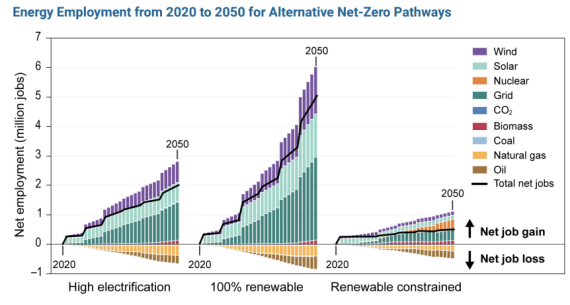
What The Science Says:
Solar development creates more jobs per unit of energy generated than other types of energy production, and renewable jobs will far exceed the jobs lost due to a shift away from fossil fuels.
Climate Myth: Solar development will destroy jobs
"Requirements for renewable energy mean that Americans’ oil and gas jobs are being sacrificed to Chinese making wind turbines and solar panels." (Heritage Foundation)
Solar development creates significantly more jobs per unit of energy generated than other types of energy production, including natural gas1. Moreover, the number of jobs created by the renewable energy industry, including solar, is expected to far exceed the number lost due to a shift away from fossil fuels. The United States’ Fifth National Climate Assessment predicts that there will be nearly 3,000,000 new solar, wind, and transmission-related jobs by 2050 in a high electrification scenario and 6,000,000 new jobs in a 100% renewable scenario, with less than 1,000,000 fossil fuel-related jobs lost2.
Figure 1: Energy employment from 2020 to 2050 under various U.S. net-zero GHG emissions scenarios. Source: U.S. Global Change Research Program.
As of 2022, the solar industry supported approximately 346,143 U.S. jobs, including 175,302 construction jobs and 44,875 manufacturing jobs, with numbers generally increasing each year3. In addition, most of these jobs cannot be outsourced. Roughly 65% of today’s U.S. solar energy jobs are in project development and 6% are in operations or maintenance, most of which cannot be exported4. The number of jobs in solar energy also exceeds those in the fossil fuel generation industries. In Kentucky, for example, there are now eight times as many jobs in clean energy, including solar, as coal mining5. Throughout the United States, there are roughly 5.4 times as many jobs in solar alone than in coal, and there are roughly 1.78 times as many jobs in solar than in coal, gas, and oil generation combined.
Domestic job growth in solar production and related industries has been further accelerated by recent federal legislation, including the 2021 Infrastructure Investment and Jobs Act, and the 2022 Inflation Reduction Act, which collectively provide more than $60 billion to support clean energy manufacturing, primarily with domestic supply chains6. In response, manufacturers have announced plans to build multibillion dollar solar panel manufacturing facilities and related battery manufacturing facilities in the United States that will employ thousands of workers7. At a smaller scale, the emerging solar recycling industry has also begun to create jobs8.
Footnotes:
[1] National Association of State Energy Officials et al., Wages, Benefits and Change (last visited March 25, 2024).
[2] U.S. Global Change Research Program, Fifth National Climate Assessment at 32-29 (2023)
[3] United States Energy & Employment Report 2023, U.S. Dep’t of Energy (June 2023).
[4] National Solar Jobs Census 2022, Interstate Renewable Energy Council (last visited March 25, 2024).
[5] Ryan Van Velzer, Kentucky has the second fastest growing clean energy sector in the U.S., Louisville Public Media, Sept. 27, 2023
[6] DOE Optimizes Structure to Implement $62 Billion in Clean Energy Investments From Bipartisan Infrastructure Law, U.S. Dep’t. Energy (Feb. 9, 2022)
[7] See, e.g., Syris Valentine, The IRA has injected $240 billion into clean energy. The US still needs more, Grist, Mar. 12, 2024; Zack Budryk, White House touts biggest single investment in US solar by Korean company, The Hill (Jan. 11, 2023); Gov. Kemp: Battery Manufacturer to Invest $2.57B, Create Over 700 Jobs in Coweta County, Governor Brian P. Kemp Office of the Governor (Nov. 11, 2022)
[8] Jon Hurdle, As Millions of Solar Panels Age Out, Recyclers Hope to Cash In, Yale Environment 360 (February 28, 2023); SOLARCYCLE Raises $30M to Scale Advanced Recycling for the Solar Industry, SolarCycle News (March 15, 2023)
[Note June 7, 2025: updated one or more link(s) to archived version(s)]
This rebuttal is based on the report "Rebutting 33 False Claims About Solar, Wind, and Electric Vehicles" written by Matthew Eisenson, Jacob Elkin, Andy Fitch, Matthew Ard, Kaya Sittinger & Samuel Lavine and published by the Sabin Center for Climate Change Law at Columbia Law School in 2024. Skeptical Science sincerely appreciates Sabin Center's generosity in collaborating with us to make this information available as widely as possible.
 |
The Skeptical Science website by Skeptical Science is licensed under a Creative Commons Attribution 3.0 Unported License. |